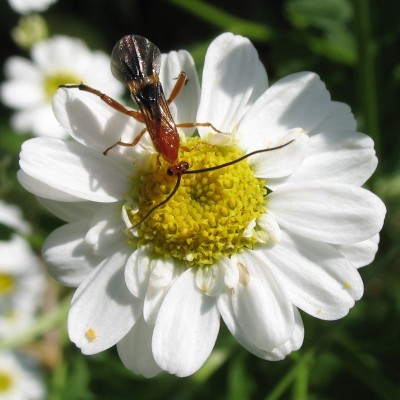






Wasps! If just the mention of them sends you running for cover, then it’s time you met the parasitic wasp. These stingless insects are your partners in fighting the battle of the bugs in your garden. Using parasitic wasps in gardens is often more effective than spraying plants with insecticides. Let’s learn more about the life cycle of the parasitic wasp and how these insects benefit the garden.
Female parasitic wasps have a long pointed structure at the end of their abdomen. It looks like a stinger, but it is actually an ovipositor. She uses it to pierce pest insects and deposit her eggs inside. When the eggs hatch, they feed inside the host insect for a short time and then they cut a hole to escape. The wasps can repeat this cycle several times a year.
Parasitic wasps usually become active in the garden later than pest insects, and some of them are so small that they are difficult to see. One way to track their progress is to watch the aphids. The skin of parasitized aphids turns crusty and golden brown or black. These mummified aphids are a good indication that parasitic wasps are doing their job.
Parasitic wasps, along with other beneficial garden insects, are very effective at keeping garden pests under control. In fact, when you spray your garden with broad spectrum insecticides, you may find that the problem gets worse instead of better. That’s because you have killed the parasitic wasps but not the pest that is causing problems.
The range of pests managed by parasitic wasps is nothing short of amazing. They effectively control aphids, scale, whiteflies, sawfly larvae, ants, leaf miners and several types of caterpillars. They also parasitize the eggs of several insects, including European corn borers, tomato hornworms, codling moths, cabbage loopers and imported cabbageworms.
Attract parasitic wasps to the garden by planting species of herbs and flowers that supply the nectar and pollen they need, including Queen Anne’s lace, dill, cilantro and fennel. They also feed on the nectar of many flowering trees and shrubs.
You can also buy parasitic wasps to release in the garden, but you should plant nectar and pollen plants first to make sure they stay where they are released.
Parasitic wasps are the most effective of the beneficial garden insects at killing aphids, and they play an important role in fighting other insects as well. With a little encouragement, they will become your garden pest control partner.
Using an Arbor to Beautify Your Garden
Shade Cover Ideas: Tips On Using Shade Cloth In Gardens
Sodium Bicarbonate In Gardens: Using Baking Soda On Plants
Garden Uses For Vinegar – Tips For Using Vinegar In Gardens
Using Geometry In Gardens: Planning A Golden Rectangle Garden
What Is A Biofungicide: Information On Using Biofungicides In Gardens
How To Repel And Get Rid Of Wasps
Wasps are Florida’s Most Common Stinging Pest
Using a Rose in Gardens Across the World
Uses For Coke In Gardens – Using Coke For Pest Control And More
Birdhouse Information – Tips For Choosing And Using Birdhouses In Gardens
Sugar On Weeds: Using Sugar To Kill Weeds In Lawn And Gardens
Copyright © www.100flowers.win Botanic Garden All Rights Reserved